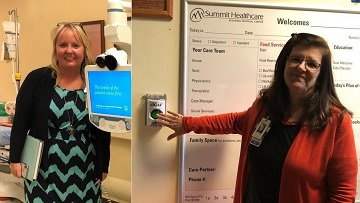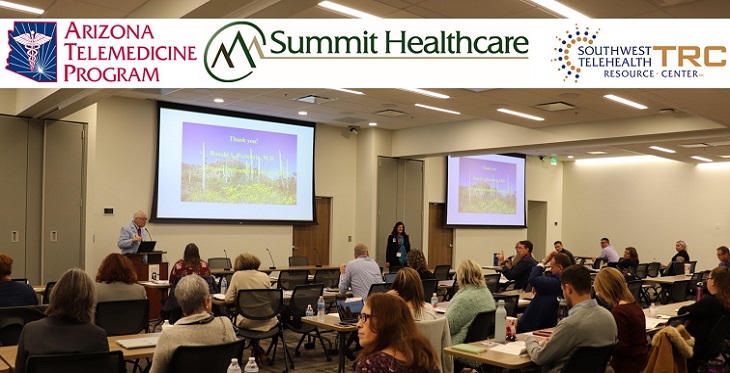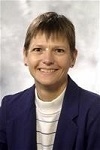In early November, the Arizona Telemedicine Program (ATP) and the Southwest Telehealth Resource Center (SWTRC) partnered with Summit Healthcare to bring “Building Innovative and Successful Telehealth Programs: Improving Access and Enhancing Care” to Show Low, a rural community located on the Mogollon Rim in east central Arizona. We were so proud to jointly produce an all-day telehealth workshop for more than 50 healthcare professionals not only from this region but from multiple states. We also were honored to be the very first special event held in Summit’s newly opened educational conference room.
The Summit partnership with ATP/SWTRC has been going strong for over eight years. Elizabeth Krupinski, PhD, SWTRC Co-Director,remembers taking the very scenic route in 2012 with Kris Erps, ATP Associate Director for Administration, from Tucson through the Salt River Canyon to Show Low for a workshop at Summit to brainstorm on strategies to implement a HRSA telehealth planning grant that Summit had just received. With support from Summit Healthcare’s leadership, telemedicine director Fredda Kermes has been able to plan, build, and very successfully implement telemedicine in this region – so successfully, in fact, that several Summit staff have become expert in their various areas and joined ATP/SWTRC staff at the training last month to share their knowledge.
Starting off the day Nancy Rowe, ATP’s Associate Director for Public Policy and Outreach brought the group up to date on the ever-evolving legal and regulatory landscape for telehealth. Her top points: 1) There are a lot of gray areas; 2) If you have questions, consult an attorney, ask a TRC, or seek guidance from regulatory agencies; 3) Laws and regulations keep changing and it’s important to keep abreast: Witness recent proposed changes to fraud and abuse laws, an anticipated DEA special registration for telemedicine, and new FDA guidance as well as the third introduction of the CONNECT for Health Act into Congress.
Paige Gray, Medical Staff Coordinator for Summit, started her presentation off in the year 1100 with a history lesson on the necessity for credentialing and licensing. She moved to the present day noting how things have changed over the years, but stressing the rationale behind credentialing and licensing and how it allows patients to confidently place their trust in their chosen healthcare providers. This talk was particularly important because licensing and credentialing can be quite confusing in the telemedicine space. If there is one take-home message, it’s make sure you’re licensed in the state where the patient is – no matter where you are!
The question of “Telemedicine’s Return on Investment: Is it Worth It?” was addressed by Dr. Krupinski. Bottom line is YES! However, it might take some reframing of what sort of ROI you’re hoping to get through telemedicine, because it isn’t just the “bottom line” that telemedicine impacts. You might see an increase in patients and thus an increase in reimbursement revenue, but cost savings from things like reduced readmissions and fewer trips to the ER might be where you find your ROI. A key point is that a telemedicine ROI is unlikely to develop in your program’s first year – the typical time to realize success is three to five years out.
Next, Ronald Weinstein, MD, ATP Director and SWTRC Co-director, shared his views on “Current Trends and Hot Topics in Telehealth.” Some of the more fascinating glimpses into the future were the likely roles of AI, clinical decision support systems, and robots in healthcare. Some of these are already working their way into healthcare systems, but the next 10 years will see a plethora of new tools, especially those driven by AI. He also shared efforts at the University of Arizona to develop cutting-edge educational facilities that incorporate telemedicine and high-tech simulation rooms to better train physicians, nurses, and other healthcare providers to improve their healthcare skills and experiences.
A lively roundtable discussion on reimbursement look place right after lunch, featuring a panel with boots-on-the-ground telehealth billing experience: Kristi Iannucci of Summit Healthcare, L’Don Sawyer of Tucson Medical Center, and Carol Yarbrough, a consultant on reimbursement and compliance. After opening statements, the audience led the discussion with high level, sophisticated billing questions. As you may have guessed, this session could have gone on for another hour! Final bits of advice included: 1) Get a revenue cycle manager on your team ASAP; 2) Bill everything and see what gets denied (the “throw-spaghetti-at-the-wall-and-see-what-sticks approach”; and 3) Don’t give up on the first denial.
Troy Laden, RN, Summit dialysis manager, shared Summit’s experience with its inpatient teledialysis program, and showed a clip of remote provider Dr. Matthew Gembala from the Arizona Kidney Disease & Hypertension Center. They developed the program because “there were a lot of people being flown off this mountain” to hospitals where inpatient dialysis was available – and where family support was a challenge due to travel and time away. The program requires staffing, equipment and supplies, policies and procedures, education, QA, and management vision and support (this is key). With telemedicine, the families still come to support the patient, but now it takes far less time, travel, and expense.
Kristi Iannucci, Network Director and IT Supervisor at Summit, who worked closely with ATP/SWTRC on developing the day’s agenda, discussed Summit’s tele-EMS program. Primary project goals: avoid lower acuity visits to the ER, improve time to treatment for critical patients, and reduce readmissions. Strategic objectives: telemedicine right at the top, incorporating EMS treat-and-refer protocols, community paramedicine, coordination of care, and education/outreach. EMS treat-and-refer required a change in the service model and training, but more EMS companies are now interested and it does reimburse. Challenges faced: competing priorities, resistance to change, and uncharted waters. The good news with navigating uncharted waters: “no one can tell me I’m doing it wrong!” Moving on to another of Summit’s teleservices, Dr. Dax Trujillo, Department Chair for Outpatient Services, discussed the telepain clinic. Dr. Trujillo was a medical student at the University of Arizona 22 years ago and remembers Dr. Weinstein as one of his professors! The telepain program has saved 16,536 total miles in patient travel so far for patients needing chronic care and treatment for pain and has helped him optimize his schedule for efficiency. Prescribing controlled substances via telemedicine can be challenging, but the prescription monitoring program is reviewed at Summit and urine samples are done at satellite locations for pain visits, helping reduce the likelihood of abuse.
Moving on to another of Summit’s teleservices, Dr. Dax Trujillo, Department Chair for Outpatient Services, discussed the telepain clinic. Dr. Trujillo was a medical student at the University of Arizona 22 years ago and remembers Dr. Weinstein as one of his professors! The telepain program has saved 16,536 total miles in patient travel so far for patients needing chronic care and treatment for pain and has helped him optimize his schedule for efficiency. Prescribing controlled substances via telemedicine can be challenging, but the prescription monitoring program is reviewed at Summit and urine samples are done at satellite locations for pain visits, helping reduce the likelihood of abuse.
Wrapping up the day, Drs. Krupinski and Weinstein shared different resources with the group and pulled Janet Major, ATP Associate Director for Distance Education and Facilities, up to give a whirlwind overview of telehealth tools and resources, including the National Consortium of Telehealth Resource Centers (NCTRC), the United States Distance Learning Association, the American Telemedicine Association, and the Society for Education and the Advancement of Research in Connected Health, and the ATP/SWTRC Service Provider Directory. In addition, resource materials were provided to attendees via a thumb drive that can be requested from the SWTRC.
ATP/SWTRC staff enjoyed the day and attendees did as well. One commented, “Just wanted to let you know what a great workshop you delivered in Show Low last Friday. I learned so much again and get more out of your workshops/trainings/information than I’ve ever received out of … any other telemedicine training.”

